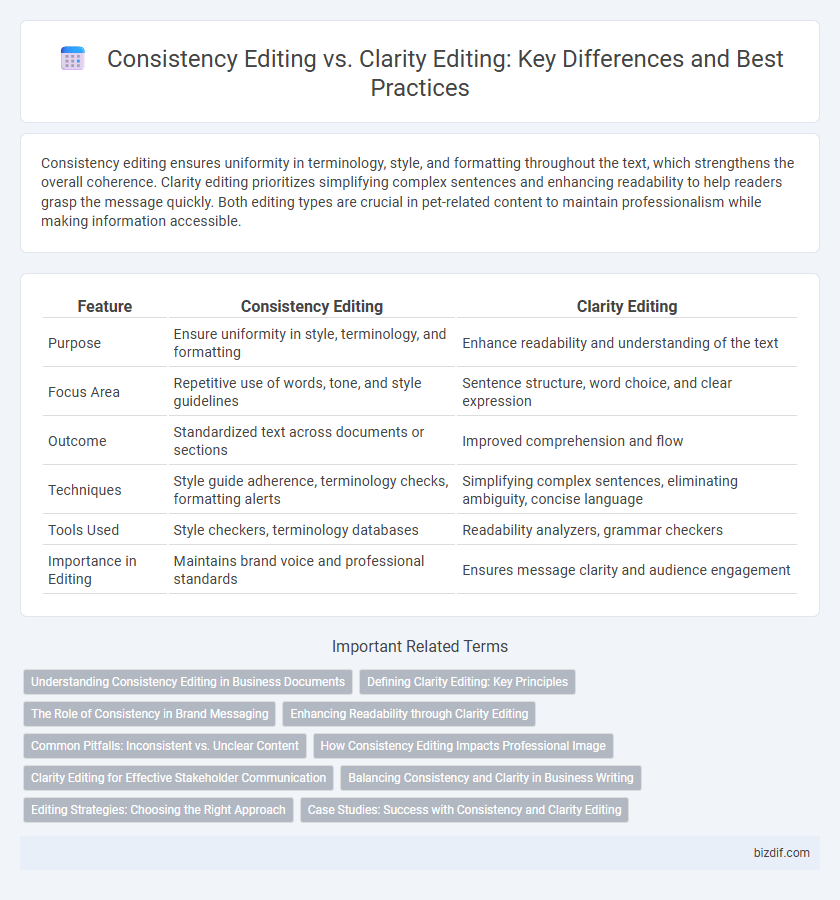Consistency editing ensures uniformity in terminology, style, and formatting throughout the text, which strengthens the overall coherence. Clarity editing prioritizes simplifying complex sentences and enhancing readability to help readers grasp the message quickly. Both editing types are crucial in pet-related content to maintain professionalism while making information accessible.
Table of Comparison
| Feature | Consistency Editing | Clarity Editing |
|---|---|---|
| Purpose | Ensure uniformity in style, terminology, and formatting | Enhance readability and understanding of the text |
| Focus Area | Repetitive use of words, tone, and style guidelines | Sentence structure, word choice, and clear expression |
| Outcome | Standardized text across documents or sections | Improved comprehension and flow |
| Techniques | Style guide adherence, terminology checks, formatting alerts | Simplifying complex sentences, eliminating ambiguity, concise language |
| Tools Used | Style checkers, terminology databases | Readability analyzers, grammar checkers |
| Importance in Editing | Maintains brand voice and professional standards | Ensures message clarity and audience engagement |
Understanding Consistency Editing in Business Documents
Consistency editing in business documents ensures uniformity in terminology, formatting, and style, which enhances professional credibility and reduces misinterpretation risks. It involves meticulous review of headings, fonts, abbreviations, and numerical formats to maintain systematic coherence throughout the document. This approach supports clear communication by establishing predictable patterns that facilitate quicker comprehension and efficient decision-making.
Defining Clarity Editing: Key Principles
Clarity editing focuses on enhancing readability by ensuring language is straightforward, sentences are concise, and ideas are presented logically. It prioritizes eliminating ambiguity, simplifying complex phrases, and improving overall flow to make the content easily understandable for the target audience. Key principles include using active voice, precise vocabulary, and maintaining coherent structure throughout the text.
The Role of Consistency in Brand Messaging
Consistency editing ensures brand messaging remains uniform across all platforms, reinforcing brand identity and building consumer trust. Clarity editing focuses on making content easily understandable, but without consistency, messages can become fragmented and weaken brand recognition. Maintaining consistency in tone, style, and terminology is crucial for a cohesive brand presence that resonates clearly with the target audience.
Enhancing Readability through Clarity Editing
Clarity editing enhances readability by simplifying complex sentences, eliminating ambiguity, and ensuring that the message is conveyed precisely to the target audience. Consistency editing focuses on uniformity in style, tone, and formatting, which supports professional presentation but does not directly impact the ease of understanding. Prioritizing clarity editing improves user engagement and comprehension, making the text more accessible and effective in communication.
Common Pitfalls: Inconsistent vs. Unclear Content
Inconsistency editing targets common pitfalls such as fluctuating terminology, tone, and format that confuse readers and reduce content professionalism. Clarity editing addresses unclear content issues, including ambiguous phrasing, convoluted sentence structure, and vague references that hinder comprehension. Both approaches are essential for polished writing but focus on different aspects of textual quality.
How Consistency Editing Impacts Professional Image
Consistency editing ensures uniformity in style, tone, and formatting across all documents, which reinforces a professional brand identity and builds trust with the audience. Maintaining consistent terminology and design elements eliminates confusion and demonstrates attention to detail, elevating the perceived quality of the content. This disciplined approach to editing directly impacts how clients and stakeholders perceive an organization's reliability and credibility.
Clarity Editing for Effective Stakeholder Communication
Clarity editing enhances stakeholder communication by ensuring that messages are precise, unambiguous, and easy to understand, reducing misunderstandings and fostering trust. This type of editing focuses on simplifying complex language, improving sentence structure, and emphasizing key information crucial for decision-making. Consistency editing supports clarity but clarity editing directly impacts how stakeholders interpret and act on the information provided.
Balancing Consistency and Clarity in Business Writing
Balancing consistency and clarity in business writing requires applying consistency editing techniques to ensure uniform terminology, formatting, and style across documents, which strengthens brand identity and professionalism. Clarity editing focuses on simplifying language, eliminating ambiguity, and organizing content logically to enhance reader comprehension and engagement. Effective business communication blends these approaches by maintaining standardized language while prioritizing clear, concise messaging tailored to the target audience.
Editing Strategies: Choosing the Right Approach
Consistency editing ensures uniformity in style, tone, and format throughout the text, which strengthens credibility and readability. Clarity editing targets simplifying complex sentences, eliminating ambiguity, and enhancing overall comprehension to engage a broader audience. Selecting the appropriate strategy depends on the document's purpose, audience, and desired impact, with many professional editors combining both approaches for optimal results.
Case Studies: Success with Consistency and Clarity Editing
Case studies reveal that consistency editing enhances brand voice uniformity across platforms, improving audience trust and recognition by up to 30%. Clarity editing boosts reader comprehension, leading to a 25% increase in engagement metrics such as time on page and user feedback scores. Combining both approaches results in optimized content performance and stronger communication effectiveness.
Consistency Editing vs Clarity Editing Infographic

 bizdif.com
bizdif.com